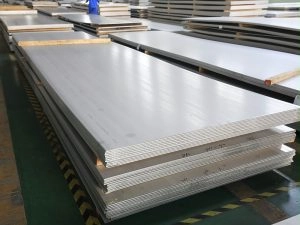Fundamental Characteristics of Stainless Steel
Corrosion Resistance
Stainless steel is well known for its ability to resist corrosion. Is commonly chosen across various industries for this reason. The resistance mainly stems from the creation of a layer of chromium oxide, on its surface that shields the steel from factors in the environment that lead to rust and deterioration. The durability of steel, in the face of chemicals, wet conditions, and different atmospheres greatly increases its longevity. Stainless steel is widely used in applications, like kitchen tools and essential parts in industries such, as aerospace and chemical processing.
Strength and Durability
Stainless steel is well known for its robustness and longevity, conditions thanks to its high tensile strength and ability to withstand pressure and extreme temperatures effectively This makes it a cost-effective option for construction and manufacturing industries as it requires less material while maintaining performance standards Its durability also plays a role in sustainability efforts by reducing the need, for frequent replacements thereby cutting down waste production and resource usage in the long run.
Versatility in Manufacturing
Stainless steel offers a range of uses due to its adaptability to production methods like welding and machining as well as its ability to be shaped into intricate forms for specific purposes. The variety of stainless steel grades and finishes allows for customization based on needs such as durability or visual appeal. This versatility has made steel an option in industries, like automotive manufacturing, surgical tools, and architectural design.
Hygienic Properties
Steel’s cleanliness and sanitation benefits are crucial. Its clean, non-porous surface prevents bacterial growth and the risk of contamination, which is crucial in industries such as food processing and healthcare where hygiene standards are a priority.
Overview of SUNRISE NEW MATERIAL Stainless Steel Products
Stainless Steel Bars
Sunrise New Material provides a selection of stainless steel bars to meet industrial requirements effectively and efficiently.
Application: manufacturing parts, frame structures, welding and bending.
Advantages: flexible and versatile, suitable for detailed processing and personalized customization.
Stainless Steel Coils
SUNRISE NEW MATERIAL stainless steel coils are crafted to offer both flexibility and strength for uses, in manufacturing and fabrication industries.
Applications: Construction and automotive industries, large-scale manufacturing processes, metal surface decoration.
Advantages: Easy to transport and store, can be processed into other forms (sheets, strips, etc.).
Varying grades of these coils cater to preferences enabling clients to choose the material, for improved functionality and lasting performance.
Stainless Steel Pipes
SUNRISE NEW MATERIAL provides stainless steel pipes.
Applications: Pipeline systems, building support, petrochemical industry, liquid and gas transportation
Advantages: Corrosion resistance, pressure resistance, adaptability to extreme temperature and pressure environments. The diverse range of sizes and fittings available offers flexibility, for tailoring to meet project needs effectively.
Stainless Steel Plates
At SUNRISE NEW MATERIAL, the stainless steel plates we produce play a role in construction projects and manufacturing processes where toughness and longevity are crucial factors to consider.
Applications: building exterior walls, kitchen appliances, industrial equipment, chemical containers.
Advantages: high structural strength, good corrosion resistance, suitable for large structures and equipment.
Moreover, their ability to resist corrosion ensures that they retain their attractiveness and structural reliability as time passes thus enhancing the importance of opting for stainless steel options.
Future Trends in Stainless Steel Development
Advancements in Alloy Compositions
The progress of stainless steel innovation is always moving forward as alloy compositions are being refined to enhance its qualities for use. Taking advantage of elements such, as chromium, nickel, molybdenum, and others researchers aim to develop alloys with better performance traits. Manufacturers focus their efforts on adjusting these compositions to create stainless steel varieties that offer enhanced resistance against pitting, crevice corrosion, and stress corrosion cracking. Factors, for challenging environments. Moreover, incorporating alloy components, into stainless steel formulations may lead to the development of stainless steel variations tailored to needs like high durability demands or distinct thermal characteristics ultimately broadening its range of applications, in various industries.
Sustainable Production Methods
With sustainability taking center stage worldwide these days the Stainless steel sector is embracing ways of manufacturing to lessen its footprint. They are working towards eco-production techniques that require energy and fewer resources yet still uphold top-notch quality standards. There’s a rising trend, in using recycled materials for making steel, which not only promotes a circular economy but also cuts down the carbon emissions linked to mining and refining activities. Cutting-edge technologies, like arc furnaces and hydrogen-based reduction methods, are currently being investigated to reduce emissions and promote an eco-friendly lifecycle for stainless steel goods. This move towards manufacturing not only meets regulatory standards but also boosts the attractiveness of stainless steel, in environmentally aware markets.
Emerging Markets and Applications
The need, for steel is growing in markets and industries driven by advancements in technology and evolving consumer preferences. With the rise of energy sources like wind turbines and solar panels steel’s durability and resistance to corrosion make it a popular choice. The automotive industry is also embracing steel for its properties that enhance fuel efficiency while maintaining safety standards. As urban areas expand globally the demand for notch steel, in contemporary architectural projects and urban infrastructure developments is soaring. There is a move, towards using steel for a variety of purposes by customizing its characteristics to match the unique needs of emerging market sectors.
Conclusion
The in-depth examination of stainless steel shapes and uses showcases the characteristics of this material and its widespread use in sectors of the industry today. Specifically known for its ability to resist corrosion, strong durability, ease of manufacture, and hygienic properties stainless steel remains a component in industrial settings. The constant advancements, in blends, production methods, and evolving market needs demonstrate the ever-evolving nature of stainless steel and its ability to meet future obstacles. As industries progress over time and adapt to change trends, in technology and innovation steel will continue to play a role as a versatile material that caters to the needs of present and upcoming generations. As professionals in this field, it is important to embrace these advancements and have an understanding of the properties of stainless steel in order to fully utilize its capabilities, in creative and innovative ways.








